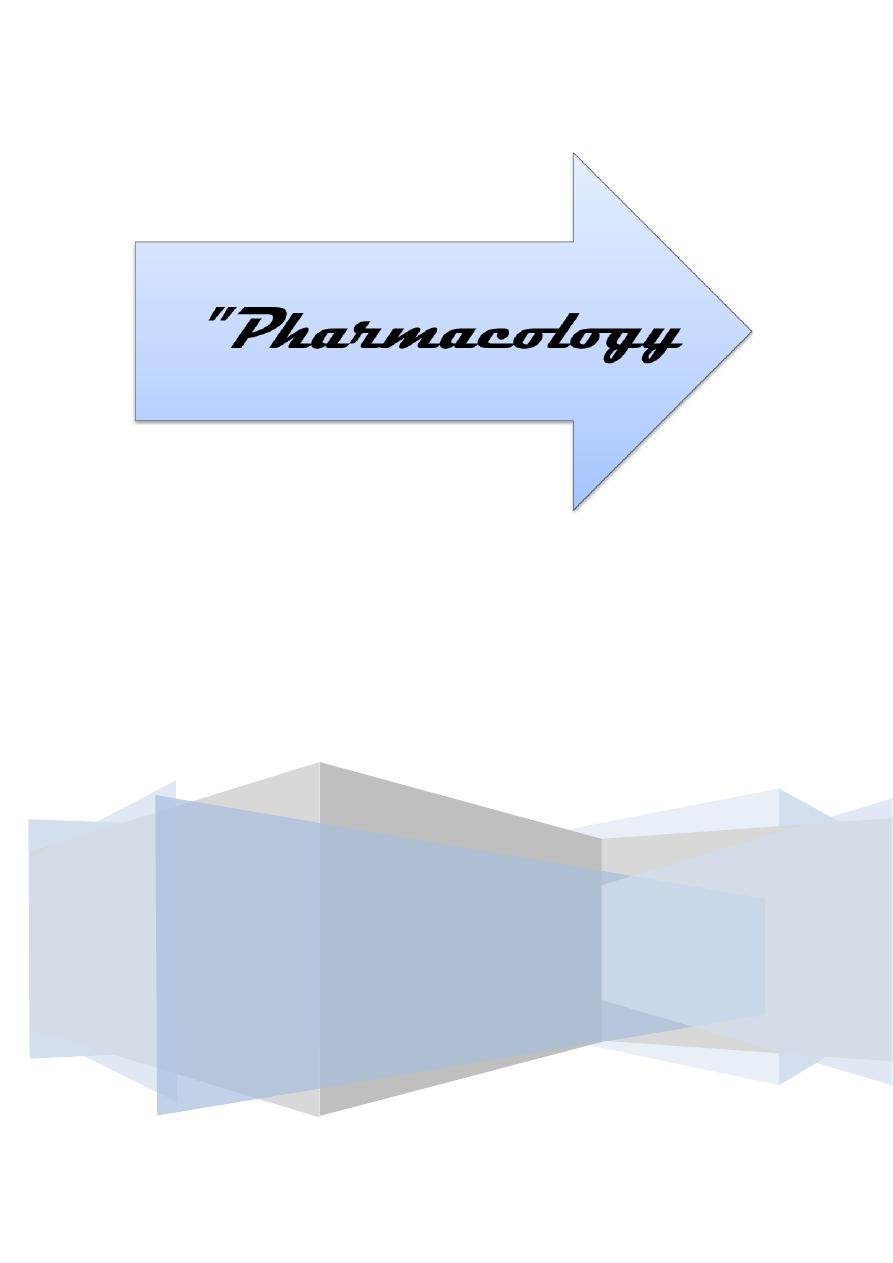
Sunday 22 / 2 / 2015
©Ali Kareem 2014-2015
Name
:
______________________________
Class
:
_______________________________
مكتب اشور لالستنساخ
ANTI-PARKINSONISM DRUGS
Lecture 4
Total lectures NO. 37
Dr. Najeeb

Drugs Used in Parkinsonism
PARKINSONISM
Pathophysiology
Parkinsonism (paralysis agitans) is a common movement disorder
That involves dysfunction in the basal ganglia and associated brain
Structures . Signs include rigidity of skeletal muscles, akinesia (or
bradykinesia), and tremor at rest .
.)
1
.
1-Naturally occurring parkinsonism—
The naturally occurring is a disease o f
uncertain origin and occurs with
frequency during aging from the fifth or sixth decade of life
onward. Pathologic characteristics include a decrease in the levels
of striatal dopamine and the degeneration of dopaminergic neurons in the
nigrostriatal tract that normally inhibit the activity of
striatal GABAergic neurons . Most of the postsynaptic dopamine receptors on
GABAergic neurons are of the D2
subclass (negatively coupled to adenylyl cyclase). The reduction
of normal dopaminergic neurotransmission leads to excessive
excitatory actions of cholinergic neurons on striatal GABAergic
neurons; thus, dopamine and acetylcholine activities are out of
balance in parkinsonism .
.)
2
.
2-Drug-induced parkinsonism—
Many drugs can cause
parkinsonian symptoms; these effects are usually reversible. The
most important drugs are the butyrophenone and phenothiazine
Reserpine deplets brain dopamine. MPTP(methyl-phenyl--tetrahydropyridine), a by-
product of the attempted synthesis of an

illicit meperidine analog, causes irreversible parkinsonism through
destruction of dopaminergic neurons in the nigrostriatal tract
. .
DRUG THERAPY OF PARKINSONISM
Strategies of drug treatment of parkinsonism involve increasing
dopamine activity in the brain, decreasing muscarinic cholinergic
activity in the brain, or both
.
Although several dopamine receptor subtypes are present in
The substantia nigra, the benefits of most antiparkinson drugs
appear to depend on activation of the D2
receptor subtype
.
1- Levodopa
1
.
Mechanisms—Because dopamine has low bioavailability
and does not readily cross the blood-brain barrier, its precursor
,
L-dopa (levodopa), is used. This amino acid enters the brain via
L-amino acid transporter (LAT) and is converted to dopamine
by the enzyme aromatic L-amino acid decarboxylase (dopa decarboxylase), which is
present in many body tissues, including the
brain.
Levodopa is usually given with carbidopa , a drug that does
not cross the blood-brain barrier but inhibits dopa decarboxylase
in peripheral tissues . With this combination, 1- the
plasma half-life is prolonged, 2- lower doses of levodopa are effective
,
and 3- there are fewer peripheral side effects
.
2
.
Pharmacologic effects—
Levodopa ameliorates the signs of
parkinsonism, particularly bradykinesia; moreover, the mortality

rate is decreased. However. Clinical response fluctuations may occur, off-periods of
akinesia may alternate over a few hours with on-periods of improved
mobility but often with dyskinesias (on-off phenomena).
.)
2
.
Toxicity—
3
.
.
GIT disturbances include anorexia, nausea, and emesis and can be reduced by
1-
taking the drug in divided doses.
.
Postural hypotension is common, especially in the early stage
2-
of treatment. Other cardiac effects include tachycardia, asystole
,
and cardiac arrhythmias
.)
3-Dyskinesias occur in up to 80% of patients, with choreoathetosis of the face
.
Some patients may exhibit chorea, ballismus, myoclonus, tics
,
and tremor
.
4-Behavioral effects may include anxiety, agitation, confusion, delusions,
hallucinations, and depression. Levodopa is contraindicated in
patients with a history of psychosis
2- Dopamine Agonists
1
.
Bromocriptine—
2
.
ergot alkaloid acts as a
An
partial agonist at dopamine D2
receptors in the brain. The drug
increases the functional activity of dopamine neurotransmitter
pathways, including those involved in extrapyramidal functions
.)
Bromocriptine has been used as an individual drug, in combinations with levodopa
(and with anticholinergic drugs), and
in patients who are refractory to or cannot tolerate levodopa
.
Adverse effects or toxicity

anorexia, nausea and vomiting
,
dyskinesias, and postural hypotension.
Behavioral effects, which
occur more commonly with bromocriptine than with newer
dopamine agonists, include confusion, hallucinations, and delusions.
Ergot-related effects include erythromelalgia and pulmonary infiltrates.
Use of bromocriptine in patients with Parkinson’s
disease has declined with the introduction of non-ergot dopamine
receptor agonists
.
2
.
Pramipexole—
This non-ergot has high affinity for the
dopamine D3
receptor. It is effective as monotherapy in mild
parkinsonism and can be used together with levodopa in more
advanced disease.
.
Adverse effects include anorexia, nausea and vomiting, postural
hypotension, and dyskinesias. Mental disturbances (confusion
,
delusions, hallucinations, impulsivity) are more common with
pramipexole than with levodopa. In rare cases, an uncontrollable tendency to fall
asleep may occur. The drug is contraindicated in patients with active peptic ulcer
disease, psychotic
illness, or recent myocardial infarction. Pramipexole may be
neuroprotective because it is reported to act as a scavenger for
hydrogen peroxide
.
.
2
Ropinirole—Another non-ergot, this drug has high affinity for the dopamine D
receptor. It is effective as monotherapy

and can be used with levodopa to smooth out response fluctuations.
.
Adverse effects and contraindications are similar to those of pramipexola
.
4
.
Apomorphine—A potent dopamine receptor agonist
,
apomorphine injected subcutaneously may provide rapid
(
within 10 min) but temporary relief (2 h) of “off-periods
”
of akinesia in patients on optimized dopaminergic therapy
.
Because of severe nausea, pretreatment for 3 days with antiemetics (eg,
trimethobenzamide) is necessary. Other side
effects of apomorphine include dyskinesias, hypotension
,
drowsiness, and sweating
.
3- Monoamine Oxidase Inhibitor
1
.
Mechanism—Selegiline and rasagiline are selective inhibitors of monoamine
oxidase type B, the form of the enzyme that
metabolizes dopamine . Hepatic metabolism of
selegiline results in the formation of desmethylselegiline (possibly
neuroprotective) and amphetamine
.
2
.
Clinical use—Selegiline has minimal efficacy in parkinsonism if
given alone but can be used adjunctively with levodopa.
Rasagiline is more potent
It has been used as monotherapy .
.
3
.
Toxicity and drug interactions—Adverse effects and interactions of monoamine
oxidase inhibitors include
insomnia, mood changes, dyskinesias, gastrointestinal distress, and hypotensioni
.
Combinations of these drugs with meperidine have resulted in
agitation, delirium, and mortality. Selegiline has been implicated
in the serotonin syndrome when used with serotonin selective
reuptake inhibitors (SSRIs
.)

4- Catechol-O-methyltransferase
(
COMT) Inhibitors
1
.
Mechanism of action—
2
.
Entacapone and tolcapone are
inhibitors of COMT, the enzyme in both the CNS and peripheral
tissues that converts levodopa to 3-O-methyldopa
(
3
-
OMD). Increased plasma levels of 3-OMD are associated with
poor response to levodopa partly because the compound competes
with levodopa for active transport into the CNS. Entacapone acts
only in the periphery
.
2
.
Clinical uses—The drugs are used individually as adjuncts to
levodopa-carbidopa, decreasing fluctuations, improving response
,
and prolonging “on-time.” . A formulation combining levodopa, carbidopa
,
and entacapone is available, simplifying the drug regimen
.
3
.
Toxicity—
4
.
Adverse effects related partly to increased levels
of levodopa include dyskinesias, gastrointestinal distress, and
postural hypotension
, Other side effects
sleep disturbances and orange discoloration of the urine
.
Tolcapone increases liver enzymes and has caused acute hepatic
failure, necessitating routine monitoring of liver function tests and
signed patient consent for use in the United States
.
5- Amantadine
1
.
Mechanism of action—
2
.
Amantadine enhances dopaminergic neurotransmission by unknown
mechanisms that may involve

increasing synthesis or release of dopamine or inhibition of dopamine reuptake. The
drug also has muscarinic blocking actions
.
3
.
Pharmacologic effects—
4
.
Amantadine may improve bradykinesia, rigidity, and tremor but is usually
effective for only a few
weeks. Amantadine also has antiviral effects
.
3
.
Toxicity—
Behavioral effects include restlessness, agitation
,
insomnia, confusion, hallucinations, and acute toxic psychosis
.
Dermatologic reactionsinclude livedo reticularis. Miscellaneous
Effects may include gastrointestinal disturbances, urinary retention, and postural
hypotension. Amantadine also causes peripheral
edema, which responds to diuretics
.
6- Acetylcholine-Blocking
(
Antimuscarinic) Drugs
1
.
Mechanism of action—
2
.
The drugs (eg, benztropine, biperiden
,
orphenadrine) decrease the excitatory actions of cholinergic neurons
on cells in the striatum by blocking muscarinic receptors
.
3
.
Pharmacologic effects—
4
.
These drugs may improve the
tremor and rigidity of parkinsonism but have little effect on
bradykinesia. They are used adjunctively in parkinsonism and
also alleviate the reversible extrapyramidal symptoms caused by
antipsychotic drugs
.
3
.
Toxicity—
CNS toxicity includes drowsiness, inattention
,

confusion, delusions, and hallucinations. Peripheral adverse effects
are typical of atropine-like drugs. These agents exacerbate tardive
dyskinesias that result from prolonged use of antipsychotic drugs .
Done by
Ali Kareem
